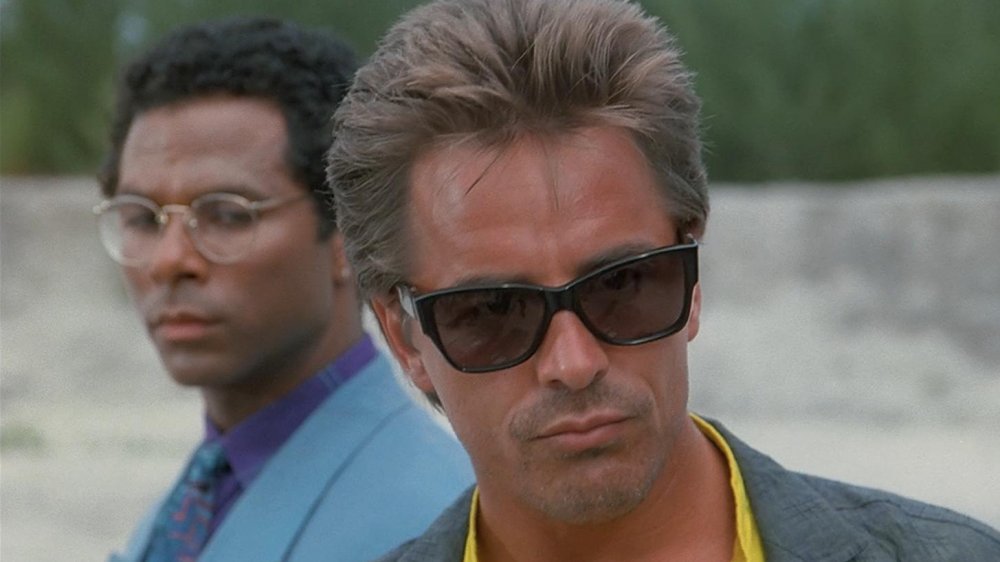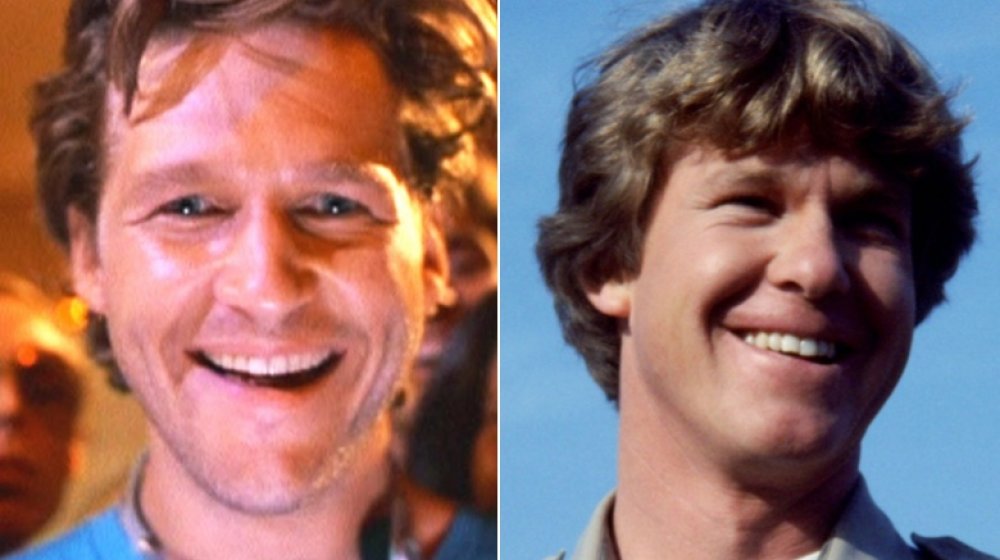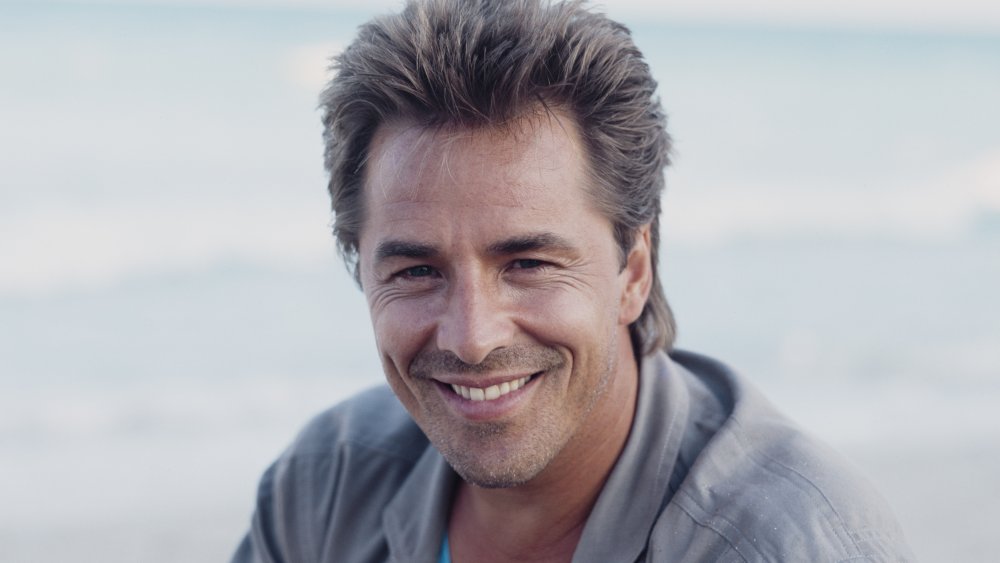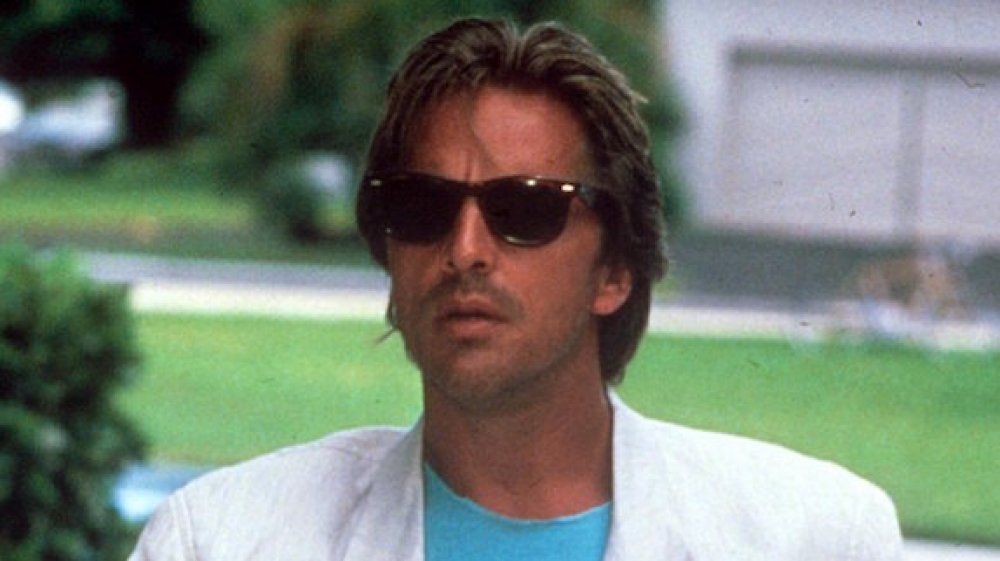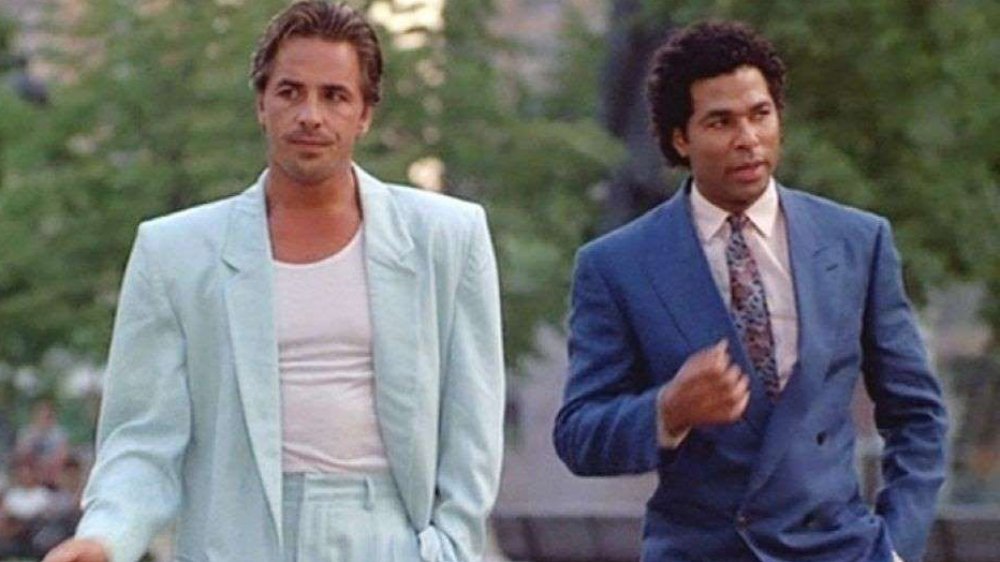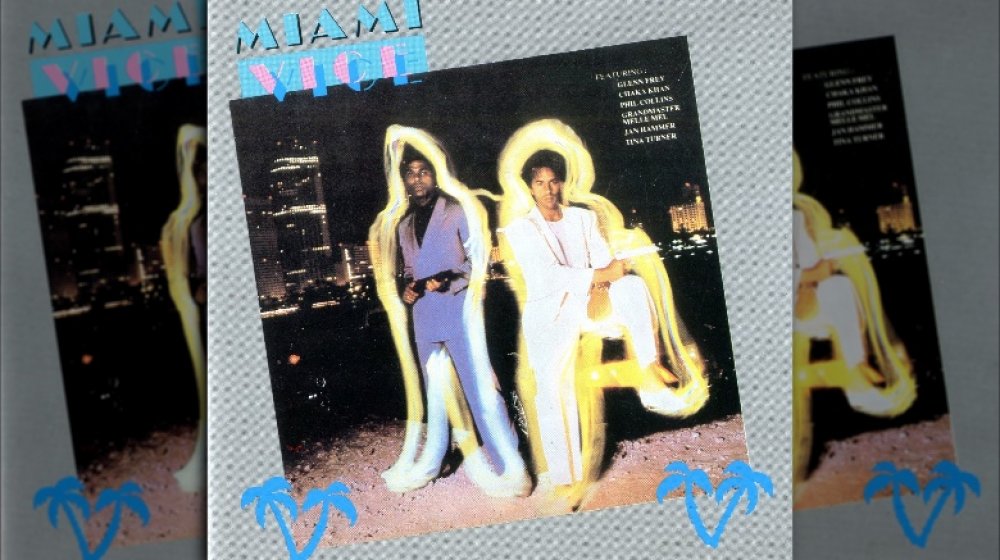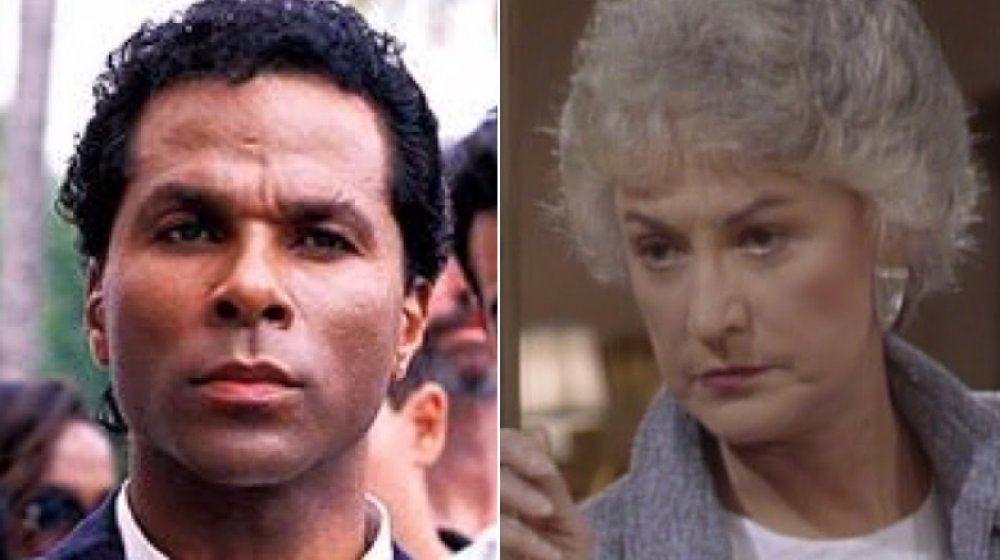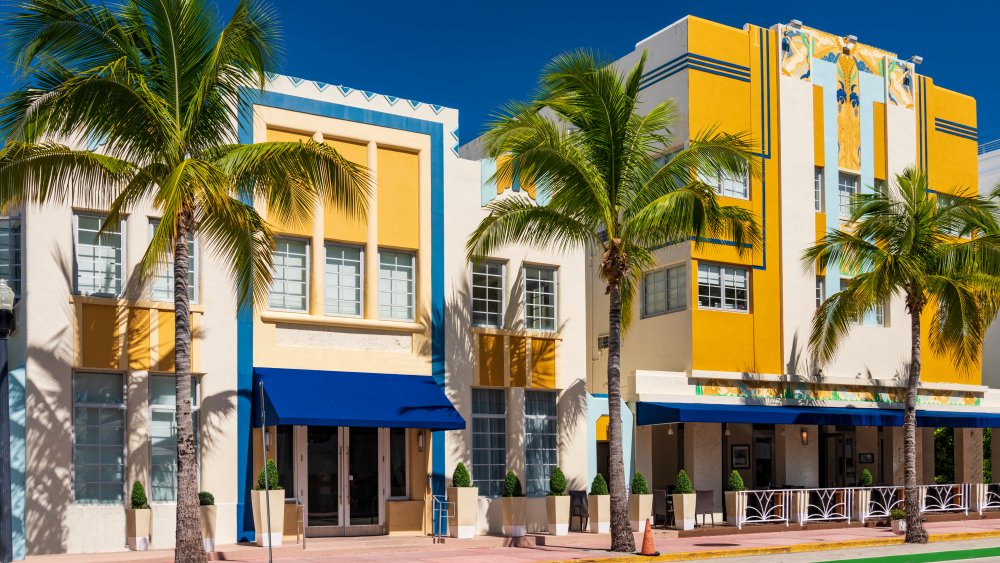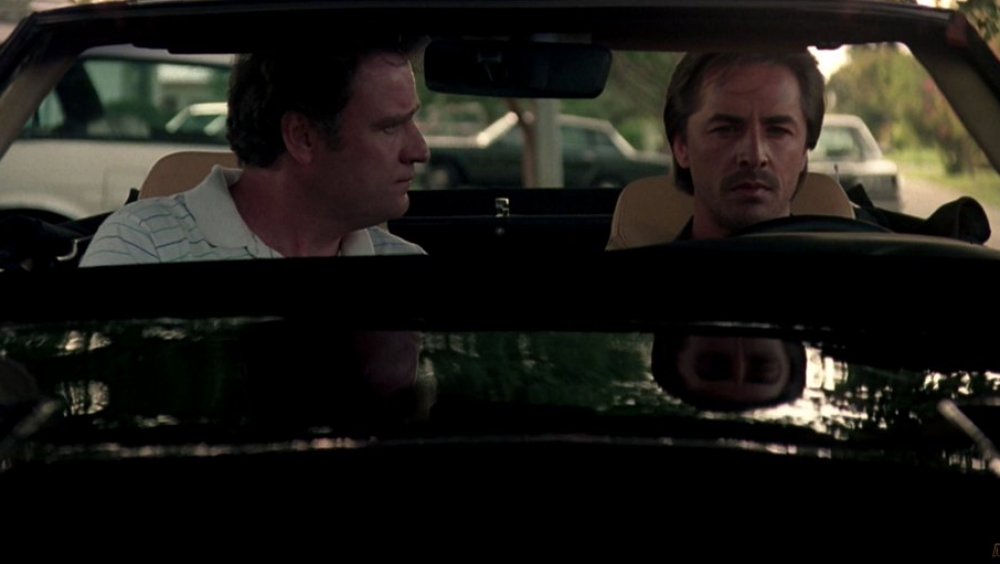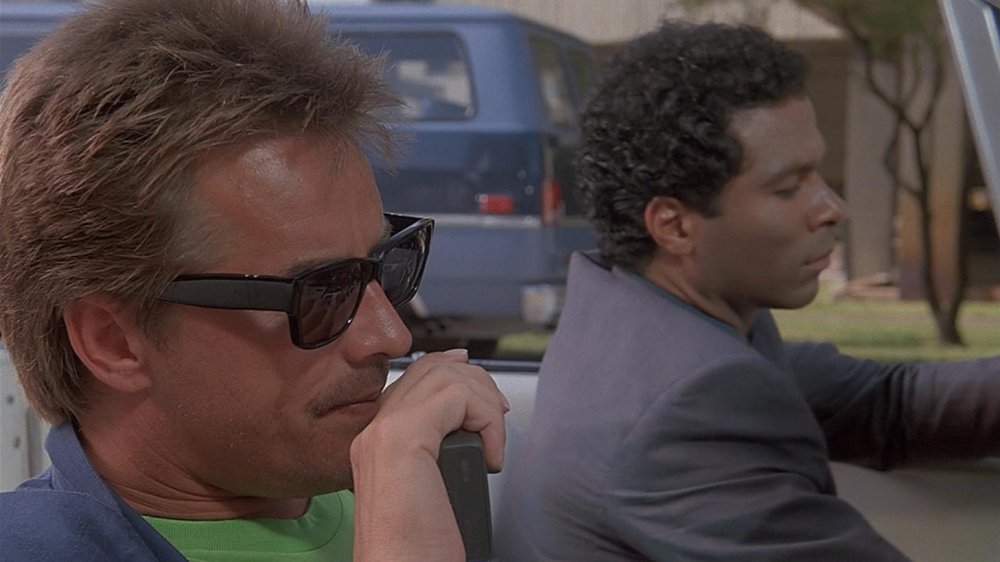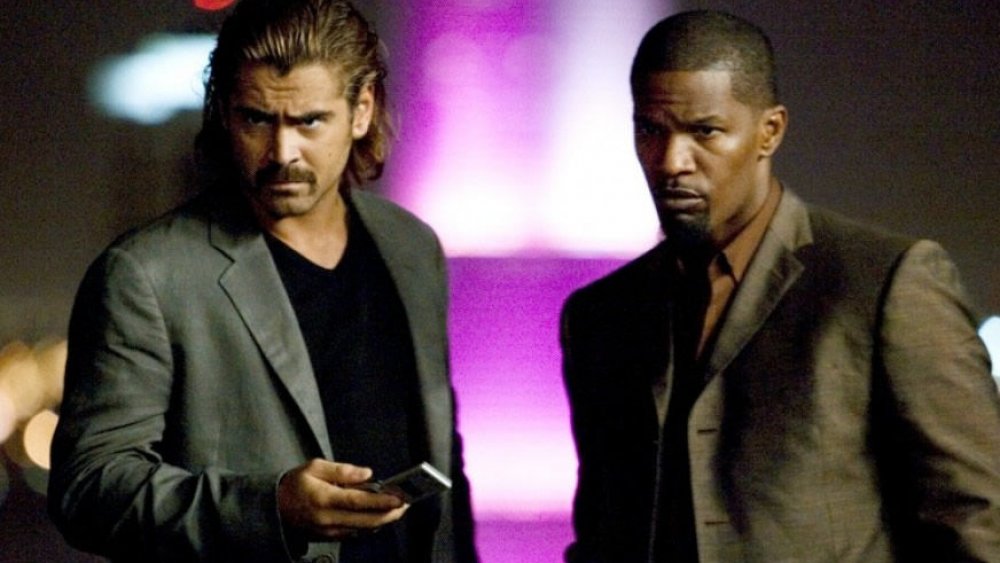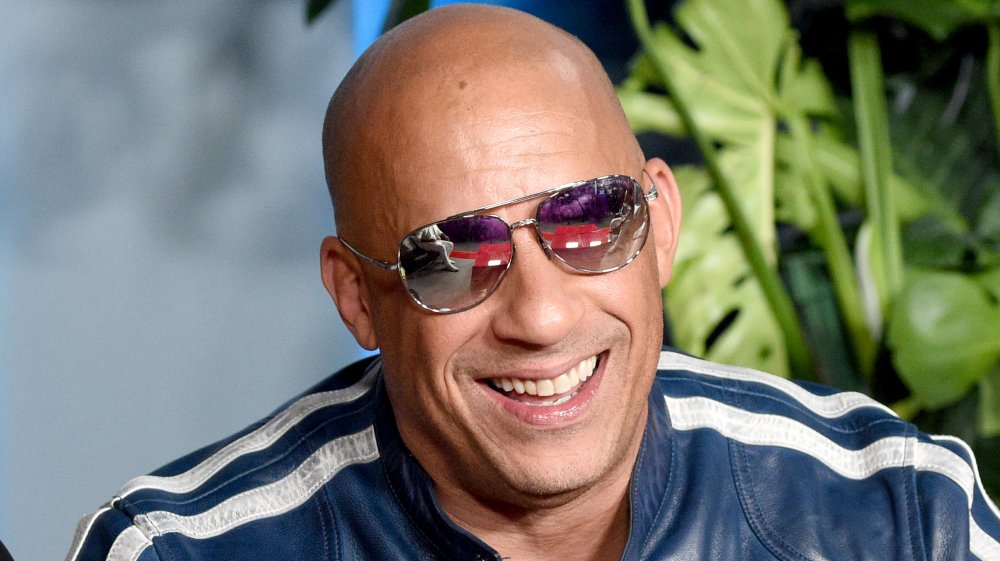The Untold Truth Of Miami Vice
When you think of the 1980s — the look, the sound, the feel — you most likely conjure up thoughts and vibes from one of the most definitive and influential TV shows of the decade. Yeah, we're talking about the 1984-1990 NBC mega-hit Miami Vice. The show starred the effortlessly cool Don Johnson and Philip Michael Thomas as the incredibly fashionable Sonny Crockett and Ricardo Tubbs, two drug-busting cops working in a sunny, beachy, brightly colored environment.
Miami Vice was a watershed moment in TV. Crockett and Tubbs fought endless, gritty criminals, and the job slowly ate at them on the inside, all from the confines of a show that looked like a bunch of quick-cut music videos and European clothing designer commercials strung together. Thoughtful and stylish, Miami Vice was a phenomenon both on TV and off, and it made stars out of those in front of and behind the camera. And with a show this big and influential, there are quite a few untold truths out there, waiting to be discovered by super stylish fans. Here's a look into the pastel-colored, stubble-covered, socks-free, and rock-scored world of Miami Vice.
The origin of Miami Vice
Miami Vice — with its fashionable cops, hip soundtrack, pet alligator, fast cars, and edgy-for-'80s-network-TV plots about drug trafficking — was unlike anything on the air at the time. Such a leap forward has to have a unique moment of inspiration. Miami Vice, in fact, has two.
In 1985, Time reported that the series sprung from the mind of NBC Entertainment president Brandon Tartikoff. See, the most revolutionary thing on '80s television to that point was MTV, a network that aired flashy, jerky, stylish music videos 24 hours a day. Tartikoff wanted NBC to cash in on the craze, and while brainstorming ideas one day, he wrote down "MTV cops." He sent along this tiny memo to Hill Street Blues writer and producer Anthony Yerkovich, who'd already started work on a project that could fit Tartikoff's vague description.
Yerkovich had gotten the idea for a movie about police officers in Miami working vice — drugs and prostitution — and turned it into a double episode-length pilot script initially titled Gold Coast. "Even when I was on Hill Street Blues, I was collecting information on Miami," Yerkovich said. "It seemed to be an interesting socioeconomic tidepool: the incredible number of refugees from Central America and Cuba, the already extensive Cuban-American community, and on top of all that, the drug trade."
Miami Vice, starring Jeff Bridgesi or the guy from CHiPs?
While Don Johnson has scored some notable parts since starring as Sonny Crockett on Miami Vice for six years — he played the title character on the light cop drama Nash Bridges and a police chief with dark secrets on HBO's Watchmen — he'll likely never move out of the very large shadow cast from his big '80s TV gig. So, it's baffling to think that NBC almost went another way.
NBC Entertainment president Brandon Tartikoff pushed hard to cast Larry Wilcox, just wrapping up a long run as a motorcycle-riding highway patrolman on CHiPs. Wilcox auditioned and filmed some fight-based test shots, only for them to cast Johnson instead, who was just coming off of five unsold pilots. At one point, the show's producers toyed with casting two major movie stars of the time, Jeff Bridges and Nick Nolte.
As for Philip Michael Thomas, the actor who played Detective Ricardo Tubbs, it's worth nothing that he was so confident in his success that he proclaimed he'd win an "EGOT" — an Emmy, Grammy, Oscar, and Tony. Thomas actually coined the term during his Miami Vice tenure ... but he was never even nominated for any of those accolades.
How Don Johnson nailed that Don Johnson look
Part of what made Miami Vice so different from other police and crime shows of the 1980s, such as Hill Street Blues or Cagney and Lacey, was its look — specifically the unique grooming style and fashion-forward clothes of Don Johnson as main character Sonny Crockett. He wasn't clean-shaven, and he didn't rock an era-appropriate mustache. However, he did sport the fuzzy beginnings of a beard, as if he hadn't had a chance to shave in a while. "The stubble was born out of the character, because it was intimated that he had been up partying with drug dealers for two or three days at a time," Johnson told Rolling Stone. "That was sort of an unspoken thing, which is why he was always unshaven and looked like he slept in his clothes." To maintain that look, as Johnson told People, he shaved his face "with a sideburn trimmer."
As for those clothes, countless guys co-opted the Sonny Crockett look — a light-colored blazer (with pushed-up sleeves) over a bright T-shirt, as well as shoes with no socks. All of those choices were just practical. "The rolled-up sleeves was a function of the fact that I had to have a jacket to cover the gun and the holster," Johnson explained. "I didn't wear socks because it was too hot to wear d**n socks." After all, they were in Miami.
Don Johnson almost left Miami Vice (and producers almost let him go)
The popularity of Miami Vice peaked in its second season. For the 1985-86 year, it ranked #9 in the Nielsen ratings. NBC naturally ordered up a third season, but star Don Johnson balked at his salary. The $35,000 per episode he'd been making up to that point was commensurate for an actor on a new, unproven show — not the mega-star of an ultra-successful hit. According to the Associated Press, Johnson wanted a raise to upwards of $100,000 per Miami Vice episode. He feuded with his bosses at Universal Television and refused to report to work until he got what he wanted.
Executives called his bluff, filing a $10 million breach of contract lawsuit and leaking the news that they were prepared to let Johnson leave the series and that they had two potential actor replacements lined up – St. Elsewhere star (and future NCIS lead) Mark Harmon and the rising Treat Williams. Shortly after those aggressive actions, the parties worked out a mutually agreeable arrangement. Johnson returned to the Miami Vice set as a newly minted member of TV's highest paid actors club, joining fellow six-figure-per-episode earners Larry Hagman of Dallas and Tom Selleck of Magnum, P.I.
The colorful world of Miami Vice
Show creator Anthony Yerkovich supervised the pilot and first five episodes of Miami Vice, then moved on to make movies for Universal Pictures, leaving many day-to-day operations in the hands of executive producer Michael Mann. The show was so young and relatively undeveloped that Mann could greatly dictate its direction, particularly its visual style and pastel-heavy color palette. Foremost, Mann sought to express Miami's uniquely bright and eye-popping look on camera, inspired by memories of the city from a mid-'70s vacation as well as a random trip to a paint store one time when he was looking at color chips.
"I was playing around with [the chips] and I realized: three colors become thematic, two colors don't," he told the Los Angeles Times. "Three colors, you can actually start telling a chromatic story. You can create a mood with three colors." As a result, Miami Vice employed a strict hues policy. "There are certain colors you are not allowed to shoot, such as red and brown," Miami Vice episode director Bobby Roth told Time. "Michael knows how things are going to look on camera. A lot of it is very basic stuff that has never been applied to TV."
Miami Vice's music was a standalone hit
Miami Vice was, to use the language of then and now, both cool and hot. It was so cool that even its very evocative theme song became the hottest pop song in the land. The extended version of "Miami Vice Theme," written and performed by former Mahavishnu Orchestra keyboard wizard Jan Hammer, went to #1 on the Billboard Hot 100 in November 1985. Hammer never made it to the pop chart again, but his composition is still one of only five TV theme songs to ever sit atop the Top 40, and as of 2020, it's the last entirely instrumental, lyrics-free song to do so.
As well as Hammer's Miami Vice theme song performed, the first Miami Vice soundtrack album did even better. Released in 1985, the record included Hammer's theme song and other bits of incidental music, along with pop songs prominently featured on the series, including Glenn Frey's "You Belong to the City" and Phil Collins' "In the Air Tonight." It spent 11 weeks at #1 on the Billboard album chart and sold four million copies, ranking it among the most successful TV tie-in albums of all time.
From Miami Vice to Miami Nice
There's an old saying about how imitation is the sincerest form of flattery, which means the people who made Miami Vice must have been very touched when, after the success of their pop music-scored and visually provocative TV show, the airwaves were flooded with ripoffs.
In 1985, a year after NBC premiered Miami Vice, ABC answered with The Insiders, which it claimed offered "contemporary music" and a "highly stylized visual approach" (via the South Florida SunSentinel). Nicholas Campbell and Stoney Jackson starred as edgy crime reporter Nick Fox and ex-con/informant Mackey, respectively. In true Vice style, the pilot episode contained fancy cars, a visceral sequence depicting a seedy crime, and most everybody dressed in hip clothes. The Insiders was cancelled after 13 episodes, but ABC's other Vice clone, Hollywood Beat, lasted 14 episodes. It featured detectives Nick McCarren (Jack Scalia) and Jack Rado (Jay Acovone) doing Crockett and Tubbs-type stuff in Los Angeles.
So Miami Vice inspired some lazy retreads, but it also helped lead to one of the most beloved and successful sitcoms of all time. Older actresses Doris Roberts and Selma Diamond performed a bit during an event announcing NBC's 1984-85 season and joked that they were starring on a show called Miami Nice. That gave NBC Entertainment president Brandon Tartikoff an idea — a show about retirement-age women all living together in Miami. That show, which hit the network in 1985 to ratings and critical success, was none other than The Golden Girls.
Miami Vice invigorated its hometown
When Miami Vice debuted in 1984, the real city of Miami wasn't as glamorous and flashy. According to the Miami Herald, the city was recovering from riots and struggling to house a large number of Haitian refugees. Plus, drug cartels had gained power and influence, and violent crime had dramatically risen. But this well-shot police show made Miami look cool and vital, particularly its rundown but historically and artistically significant buildings in the Art Deco architectural style. That's a big part of what makes the city's South Beach nightlife district so attractive, a concept Miami Vice "practically invented," as the Miami Herald explained.
Crews fixed up and painted over — with bright and pastel colors — the dulled-with-time exteriors of disused buildings, providing Miami with a free makeover that was revitalizing and restorative. "We painted the facades of virtually every building up and down Collins Avenue and Ocean Avenue to match the color palettes we had for the show," star Don Johnson told Rolling Stone, adding, "The whole town kind of reinvented itself in the image of a television show."
All those reworked buildings allowed new businesses — hotels, restaurants, and nightclubs — in Miami to flourish. And flourish they did, turning South Beach into a tourist destination, initially catering to big fans of Miami Vice.
The fast and fake cars of Miami Vice
Not only did Crockett and Tubbs dress cool, they drove cool cars, too. Frequently going undercover — and having access to sweet wheels that the Miami Police Department seized from drug lords — meant that the cops of Miami Vice needed and could drive some enviable automobiles. Detective Stan Switek (Michael Talbott) drove a 1963 Ford Thunderbird, Detective Tubbs had a 1963 Cadillac DeVille, and Detective Crockett initially cruised to Miami's seediest sectors in what was supposed to be a Ferrari 365 GTB/4 Daytona Spyder. According to Popular Mechanics, it wasn't actually a Ferrari, though. Instead, it was custom-made for the show, assembled out of a 1980 Corvette with some Ferrari parts.
This car garnered so much attention from fans and car lovers that it rubbed executives at Ferrari the wrong way. Seeking to divert attention away from a car that wasn't commercially available — and one primarily built out of a rival company's parts – Ferrari North America provided two brand new Ferrari Testarossas to the Miami Vice production. They arrived painted black, but when the cars didn't look good in some of the show's many nighttime scenes, the crew threw on some white paint.
Miami Vice was an extremely expensive show
What did all those things that made Miami Vice so fresh and original — like dressing up Miami neighborhoods so the buildings are the right colors and securing the use of gussied-up sports cars — actually cost? Well ... they cost a lot.
In the first season of the show in 1984-85, producers spent about $1.3 million per episode, according to Time. That's 30 percent more than what other police series spent for an installment at the time, and adjusted to 2020 dollars, Miami Vice cost $3.1 million an episode. (And that's before Don Johnson's substantial pay raise put him into the upper echelon of best-paid TV stars.)
A substantial segment of the budget each week went to music. Early in its run, Miami Vice soundtrack supervisors spent about $10,000 each week to license pre-existing, well-known pop and rock songs by the likes of U2, Tina Turner, Phil Collins, and Roxy Music. That costs a lot more than just hiring studio musicians to make a generic, soft-rock score.
The early 2000s Miami Vice reboot wasn't well-received
Miami Vice faded into the collective turquoise-and-pink-tinted memory in 1989 after falling to #64 in the annual Nielsen ratings, no longer the white-hot show it was just a few years earlier. By the mid-2000s, the franchise's good name had switched from passé to nostalgia, and series executive producer Michael Mann had evolved into an accomplished and lauded filmmaker (he earned an Oscar nomination for directing The Insider), which made for the perfect climate for a Miami Vice revival on the big screen.
According to Kinetoscope, the film's production was anything but perfect, going over budget and enduring filming delays. Star Jamie Foxx (as Ricardo Tubbs) grew so disenchanted that he left the film during a location shoot in the Dominican Republic and refused to come back for any overseas work, forcing Mann to rewrite the ending and abandon plans to shoot in Paraguay, according to Slate. Foxx and Mann really didn't get along, but that wasn't an isolated situation. "Michael dressed down everybody and humiliated everybody," a crew member said.
Audiences, likely used to campy, ironic movie versions of era-definitive TV shows (such as The Brady Bunch Movie) seemingly weren't ready for a gritty, dark, R-rated drug trafficking thriller that just so happened to feature two characters named Crockett (Colin Farrell) and Tubbs. Along with so-so critical reviews, the 2006 film earned a middling $63 million at the domestic box office, less than half of the film's enormous $135 million budget.
Is a reboot with Vin Diesel on the way?
If filmmakers or producers had any plans to bring back Miami Vice in the wake of the 2006 film version, the movie's lackluster performance likely buried those plans in the ground. But 2006 is a millennium ago to Hollywood, and in the 2010s, talks began on giving Miami Vice another, high-profile shot. According to LatinoReview (via Slashfilm), in 2014, Universal Pictures actively accepted pitches from screenwriters who wanted to take a shot at launching a new franchise of Crockett and Tubbs-headlined adventures. Those films never came, but later that year, original series star Don Johnson told Rolling Stone that there was "talk recently about doing new episodes" and that he had a few ideas on how to pass the torch, narratively speaking, to a new generation of vice cops.
In 2017, nearly three years later after those negotiations allegedly took place, Variety reported that movie star Vin Diesel and producer Chris Morgan were hard at work on a new Miami Vice for NBC, which aired the original Miami Vice in the '80s. TV writer Peter Macmanus, who'd penned episodes of The Mist and Satisfaction, was hired to write the pilot script, but that new Vice never showed up, either.

